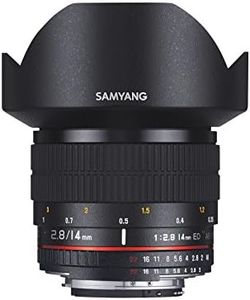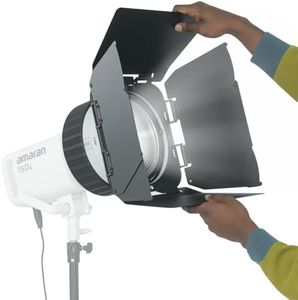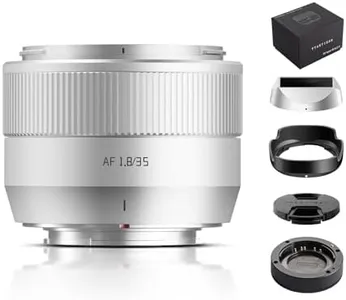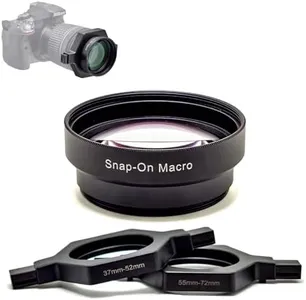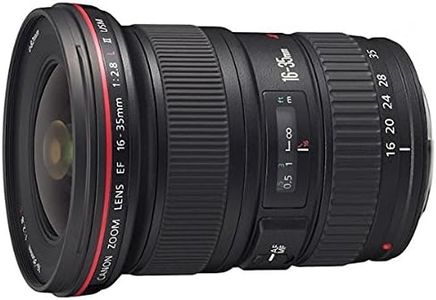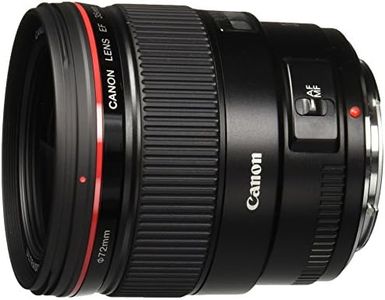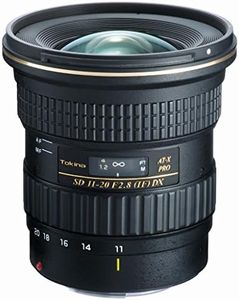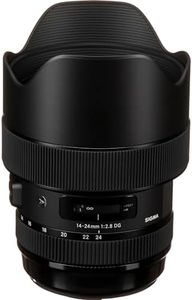10 Best Canon Wide Angle Lenses 2025 in the United States
Our technology thoroughly searches through the online shopping world, reviewing hundreds of sites. We then process and analyze this information, updating in real-time to bring you the latest top-rated products. This way, you always get the best and most current options available.

Our Top Picks
Winner
Samyang 12mm F2.0 AF Ultra Wide Angle Lens for Canon RF-S Mount – Compact APS-C Prime, Fast F2 Aperture, Autofocus, Weather Sealed, Linear STM, 62mm Filter, Ideal for Travel, and Night Photography
Most important from
176 reviews
The Samyang 12mm F2.0 AF lens is a strong option for Canon RF-S users who want an ultra-wide-angle prime lens that performs well in many conditions. Its 12mm focal length offers a very wide 99.1° field of view, making it great for capturing expansive landscapes, interiors, and night skies. The fast f/2.0 aperture stands out in low-light situations, allowing for clearer shots without needing very high ISO, and it also helps create a nice background blur when desired. Optical quality is high, thanks to multiple special lens elements and coatings that reduce distortion, chromatic aberration, and flare — common challenges with ultra-wide lenses. Autofocus is smooth, quick, and quiet due to the Linear STM motor, which is especially useful if you switch between photography and video.
The lens is compact and lightweight, which is a big plus for travel or outdoor use, and its weather sealing adds durability and reliability in different conditions. However, it lacks built-in image stabilization, which means you might need a steady hand or tripod for longer exposures or video. While its build is solid, the compact size and prime design mean it’s less versatile than zoom lenses for those needing multiple focal lengths. This lens suits photographers who prioritize wide-angle quality, low-light ability, and portability over zoom flexibility or stabilization.
Most important from
176 reviews
Canon EF 16–35mm f/2.8L III USM Lens, Black (0573C002)
Most important from
139 reviews
The Canon EF 16–35mm f/2.8L III USM Lens is a high-performance wide-angle lens, ideal for photographers who require excellent sharpness and a consistent f/2.8 aperture throughout its zoom range. The lens' focal length of 16-35mm makes it versatile for landscapes, architecture, and even some portrait photography. One of its standout features is the new optical design that significantly enhances sharpness in the outer and corner areas, addressing common issues in wide-angle lenses.
Additionally, the Sub Wavelength Coating (SWC) and Air Sphere Coating (ASC) effectively reduce flare and ghosting, ensuring high-quality images even in challenging lighting conditions. This lens is also built to withstand tough environments with its robust weather sealing, making it a reliable choice for outdoor and travel photographers. The 9-blade circular aperture helps to create beautiful, soft backgrounds which can be appealing for creative shots.
However, this lens is not compatible with extenders, which may limit its use for certain specialized photography needs. Also, while its weight of 1.74 pounds is manageable, it may feel heavy for extended handheld use. With a strong build quality, fast and accurate autofocus, and excellent image stabilization, this Canon lens is a great investment for serious photographers who need a reliable and high-performing wide-angle lens.
Most important from
139 reviews
Samyang 14mm F2.8 Full Frame Ultra Wide Angle Lens for Canon EF Mount Cameras with AE Chip, Black, one Size, SYAE14M-C
Most important from
453 reviews
The Samyang 14mm F2.8 lens offers a true ultra-wide 14mm focal length with a bright f/2.8 aperture, making it great for capturing dramatic landscapes, architecture, and creative wide scenes. Its wide 115° field of view provides immersive shots that work well on both full-frame and APS-C Canon cameras. The lens is manual focus only, which might be challenging if you need quick autofocus, but the smooth focus ring and close focusing distance (around 10.8 inches) allow for precise control and creative close-up shots. It does not have image stabilization, so using a tripod is recommended for sharp photos in low light or longer exposures.
Samyang uses special glass elements to reduce distortion and chromatic aberration, helping produce sharp and vibrant images from corner to corner. The built-in AE chip helps the camera meter exposure correctly, so you won't have issues with exposure settings. Build quality is solid with a petal-shaped lens hood to reduce flare and protect the lens, although it is relatively lightweight and compact for easy use outdoors or in the studio.
This lens is best suited for photographers who prioritize image quality and wide angles but don’t mind manual focusing and the absence of image stabilization. It represents a budget-friendly option for enthusiasts and professionals wanting a high-quality ultra-wide perspective without the higher cost of autofocus lenses.
Most important from
453 reviews
Buying Guide for the Best Canon Wide Angle Lenses
Choosing the right wide-angle lens for your Canon camera can significantly enhance your photography, especially for landscapes, architecture, and interior shots. Wide-angle lenses allow you to capture more of the scene in a single frame, making them ideal for expansive views and tight spaces. When selecting a wide-angle lens, it's important to consider several key specifications to ensure you get the best fit for your needs. Understanding these specs will help you make an informed decision and get the most out of your photography experience.FAQ
Most Popular Categories Right Now


